Contents
Garlic pests can significantly reduce crop yields. To protect plantings from insects, you need to study the main parasites and methods of counteraction.
Pests of garlic
Pests on garlic leaves are not so common – the plant secretes phytoncides that naturally repel parasites. But some insects still pose a threat to the culture.
aphid
A small insect with a rounded yellow-green or black body densely sticks to the growing garlic from the neck to the arrows. The parasite feeds on plant sap and attacks the culture in large colonies. Aphids can completely destroy garlic in a few days, so it is necessary to deal with it immediately after detection. The parasite appears on the beds usually in May and poses a threat to plantings until the fall, as it breeds in waves.
Finding aphids is quite simple with a careful examination of the culture. In addition to the insects themselves, the yellowing of young feathers indicates the infection of the plantings. Garlic becomes flabby and shriveled, underground heads stop developing.
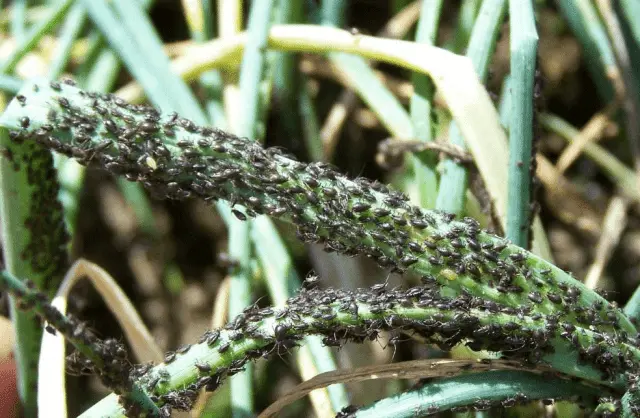
Aphids are also dangerous for garlic because they are a carrier of fungal and viral diseases.
root mite
A miniature pest of winter garlic has a translucent body up to 0,7 mm long. Appears on beds in the soil, grows from an egg into an adult in an average of 40 days. In the process of development, it eats ripening tubers, instead of juicy cloves, as a result, one dust remains.
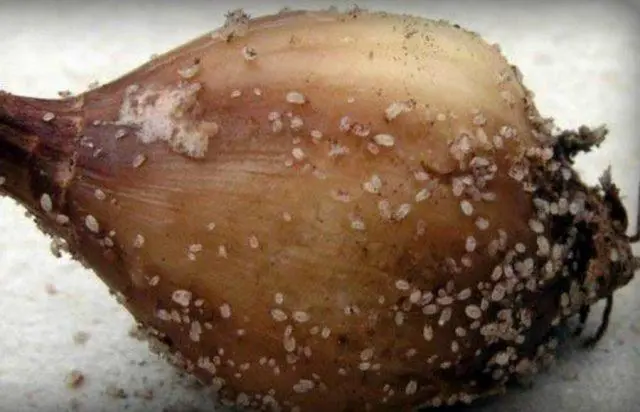
Root mite on garlic heads appears in hot and humid weather
Four-legged garlic mite
A common pest of winter garlic has microscopic dimensions – only about 0,2 mm. It is almost impossible to see the parasite with the naked eye. But you can pay attention to indirect signs indicating its presence.
In a plant affected by a four-legged tick, the leaves begin to curl towards the middle and turn yellow along the edges. Then, dark green or brownish spots appear on the underground tubers.
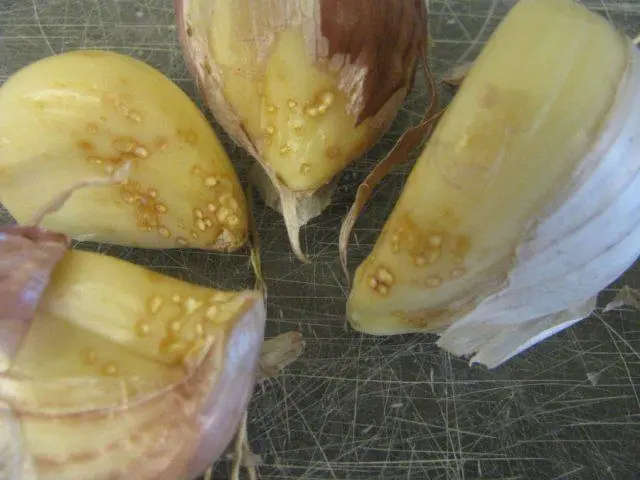
Garlic four-legged mite actively harms ripening heads at temperatures above 20 ° C
Lukovaâ flies
A dangerous pest appears on the beds most often in May. Reaches 1 cm in length, has a grayish body, white parasite larvae. The fly lays its eggs in the ground next to the garlic or directly on the lower leaves. The hatching larvae of the pest make their way inside the emerging teeth and actively eat them. As a result, garlic heads soften and quickly rot.
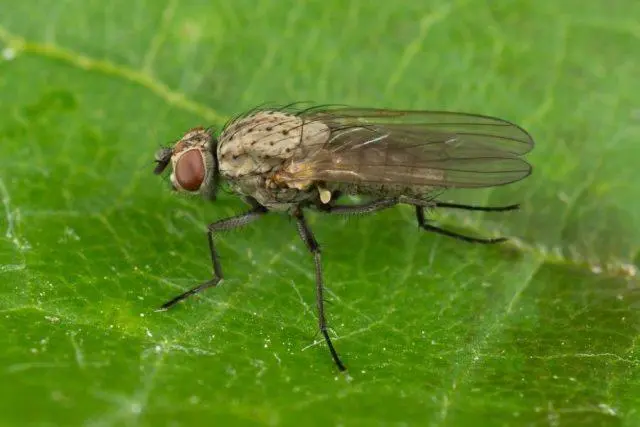
Onion fly damages garlic in June and late July
Onion moth
The night butterfly has a small gray-brown body and wingspan up to 1,4 cm. Adults do not directly harm the garlic heads, but lay yellowish small eggs between the leaves. Greenish caterpillars emerge from them and begin to eat the plates. Irregularly shaped spots or light longitudinal stripes appear on the leaves, the garlic wilts and gradually dies.
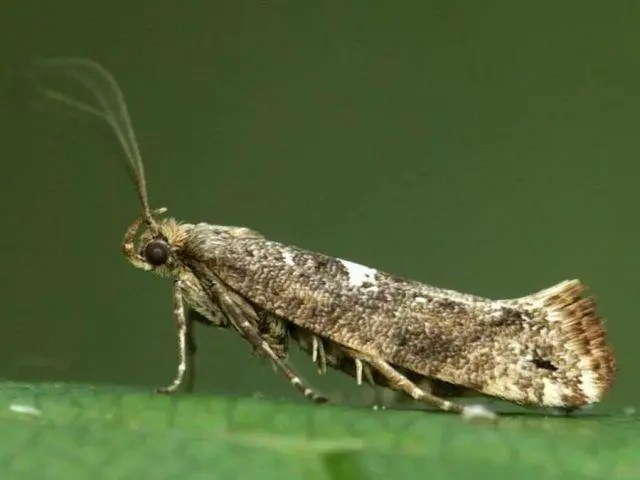
Onion moth is especially active in dry weather
Onion whetstone
A dangerous garlic pest in adulthood is a small butterfly with whitish-gray pubescent wings. Lays a large number of eggs on the leaves of the plant. The hatched butterfly larvae look like thick caterpillars with a pinkish body up to 2,5 cm in length.
Pests penetrate the garlic cloves ripening underground and eat the pulp. The crop eventually rots or dries out. Although the caterpillars begin eating tubers in mid-summer, they are often only found in August and September when picking garlic heads. This is the particular danger of the onion whetstone – it is almost impossible to find out about its presence by indirect signs.
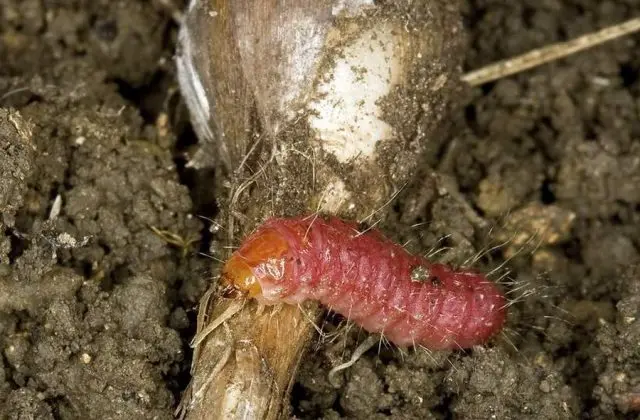
Onion whetstone reproduces very actively – up to 30 caterpillars can be present in one head of garlic
The stem nematode
The garlic nematode is a small white worm that feeds on plant sap. As the name suggests, the parasite lives on the stems of the crop. It is difficult to see the nematode with the naked eye, but brownish spots on the leaves make it possible to suspect its presence. With a strong pest attack, feathers are deformed in garlic.
The nematode begins to actively develop at a temperature of 12-16 ° C, it can appear both in spring and in mid-autumn. The life span of the pest is no more than 20 days. A feature of the parasite is increased resistance to bad weather. In adverse conditions, he does not die, but simply falls asleep, while maintaining viability up to 7-8 years.

The stem nematode begins to actively harm garlic in conditions of heat and high humidity.
Weevil
A small pest is a black or gray beetle with a curved proboscis, reaching about 3 mm in length. The parasite hibernates in the soil under plant debris, wakes up in early spring and lays eggs on garlic leaves. They hatch into yellow-brown larvae with a body up to 6,5 mm and begin to eat green feathers.
The phase of the greatest activity of the weevil begins in May and lasts until the end of June. It is difficult to see the pest on garlic, but white stripes on the aerial parts speak of its presence. The weevil does not directly touch the cloves of the culture, however, if the leaves are damaged, one way or another, the nutrition processes of the plant are disrupted. The vegetable begins to turn yellow and gradually dies, the volume and quality of the crop are reduced.
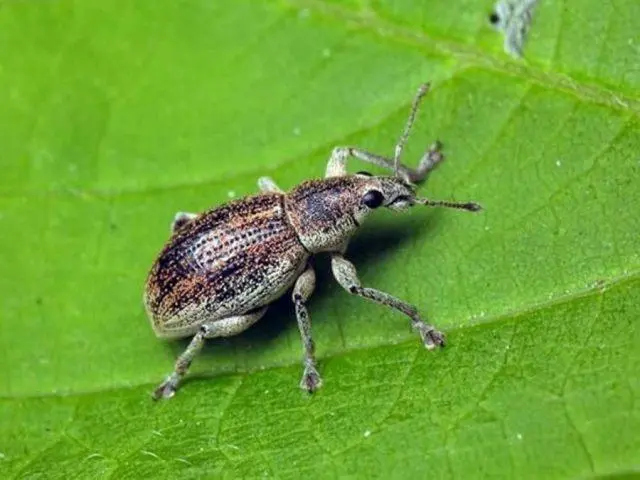
Both weevil larvae and adult beetles feed on garlic.
thrips
Garlic in the garden is often harmed by thrips – a parasite up to 1,1 mm in length with narrow brown or beige wings. Insect larvae are white at birth, then turn yellowish green.
Tobacco thrips settles in the axils of garlic leaves and lays eggs there. During one season, it can give up to three generations in the open field. The pest begins to massively damage garlic in June, and the first insects appear on the leaves as early as May. The path from the larva to the adult thrips parasite takes an average of 2-4 weeks.
The pest feeds on the juice of shoots, leaves and peduncles of garlic, causes necrosis and white stripes on the aerial parts. The bulbs are usually not touched, but the cloves grow very small and weak. When affected by tobacco thrips, garlic becomes vulnerable to infectious and viral diseases.
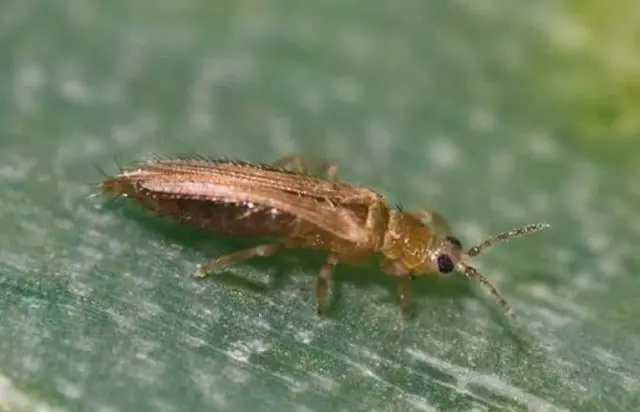
Tobacco thrips can multiply in ripe garlic heads between scales at a temperature of about 18 ° C
How to spray garlic from pests
It is necessary to fight pests on garlic. Insects reduce not only the volume of the crop, but also its quality, making the heads unfit for consumption. To eliminate parasites, it is allowed to use both folk and purchased remedies.
Pest control garlic folk remedies
Folk remedies help to get rid of pests of garlic with a weak defeat of plantings. Their advantages include low toxicity – homemade infusions and decoctions do not impair the quality of the crop.
Decoction of tansy
Tansy decoction has a pungent odor and repels pests. Prepare the tool according to this scheme:
- Fall asleep in an enameled bucket 3 kg of fresh flowers.
- Fill raw materials with water to the top and bring to a boil.
- Keep on medium heat for about 15 minutes.
- Remove from stove and cool.
Strained broth is poured into a spray bottle and sprayed with growing garlic. Processing is carried out 1-2 times a month throughout the season.
Yarrow infusion
Another home remedy brings a good effect on aphids and butterfly caterpillars. Prepare the infusion according to the following algorithm:
- Young shoots of yarrow are crushed in the amount of 800 g.
- Pour raw materials with 3 liters of boiling water.
- Leave covered for 40 minutes.
- Top up the infusion with another 7 liters of water.
- Withstand for a day and filter.
The resulting product is treated with beds several times per season. If necessary, you can not only spray, but also pour garlic from pests – for example, from a root mite that lives in the soil.
pepper tincture
A fragrant tincture of hot pepper helps well against aphids, weevil and tobacco thrips. Do it like this:
- Pour 1 kg of fresh fruits with a bucket of water.
- Boil on low heat for an hour.
- Closed, place in a dark place for a day.
- After the expiration date, filter.
About 125 ml of the resulting concentrated product is diluted in 10 liters of pure water. The infusion is used to spray garlic every two weeks.
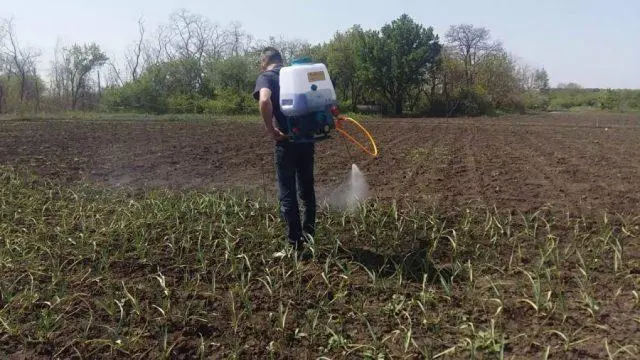
It is necessary to spray garlic from pests in low-sunny, but dry weather.
Chemicals
You can process garlic from pests in May or summer not only with folk, but also with ready-made purchased products. The use of chemicals is recommended for severe damage to the crop – more than 10% of plantings. Home infusions in such cases usually simply do not give results.
Carbophos
One of the best drugs against pests of garlic is Karbofos. The tool demonstrates high efficiency against aphids, thrips, weevils and other insects.
You can dilute the drug for use as follows:
- About 60 g of dry granules are poured with a small amount of water.
- Mix thoroughly.
- Top up the concentrate with clean water up to 10 liters.
Spraying is carried out in the morning or evening in the absence of bright sun.

For 10 m2 of a garden when using Karbofos, it is necessary to spend about 1 liter of solution
Pyrimore
The insecticide belongs to the category of toxic carbamates, inhibits pests of garlic, but does not harm beneficial insects. Dilute the drug as follows:
- A concentrate is made from 30 g of a chemical agent and 200 ml of liquid.
- A homogeneous solution is added to 10 liters of water.
- Stir the product properly.
Spraying garlic with Pirimor is necessary at the first symptoms of pest damage.
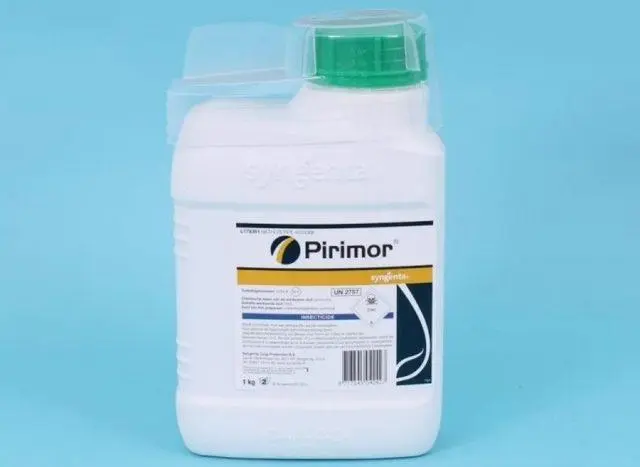
Pirimor and other chemicals for garlic should be applied no later than 2-3 weeks before harvesting.
preventive measures
Many garlic pests can be successfully controlled. However, it is better not to allow the appearance of parasites at all. To do this, you must follow the basic rules of prevention:
- Preplant preparation. Before sowing, garlic cloves must be disinfected in a weak solution of potassium permanganate. This will strengthen the immunity of the culture and eliminate possible pest larvae, if they are already present in the planting material.
- Compliance with crop rotation. Each season, garlic beds need to be moved to a new place. It is allowed to return the culture to the old site only after 4-5 years.
- Regular weed control. Many garlic pests first feed on self-seeding herbs and only then spread to the cultivated plant. In addition to weeding, it is recommended to loosen the soil – in this case, it will be more difficult for parasites to develop in the soil.
- Thorough fall cleaning. After harvesting the garlic, it is necessary to remove all plant debris and carefully dig the bed. It is also advisable to immediately disinfect the soil with a solution of potassium permanganate or copper sulfate.
When growing garlic, it is necessary to water the beds on time and regularly apply complex fertilizers. Weakened plants that do not receive enough nutrients most often suffer from pests and diseases.
Conclusion
Garlic pests impair crop development and reduce yields. Some parasites lead only to chopping vegetable heads, others are able to completely destroy them. You can fight insects with folk and chemical means.









